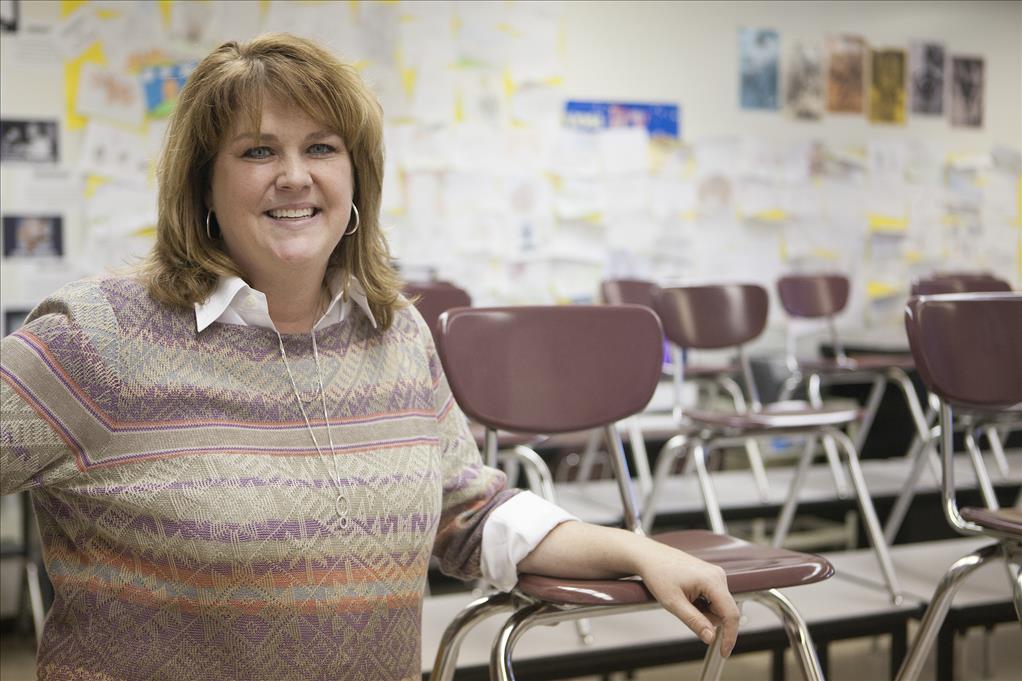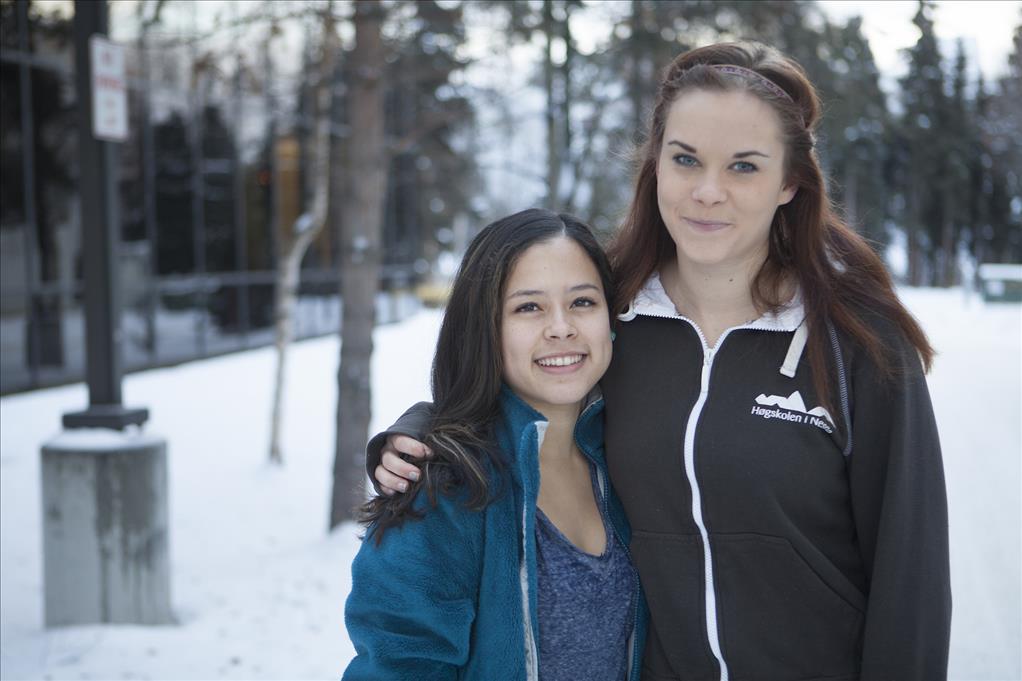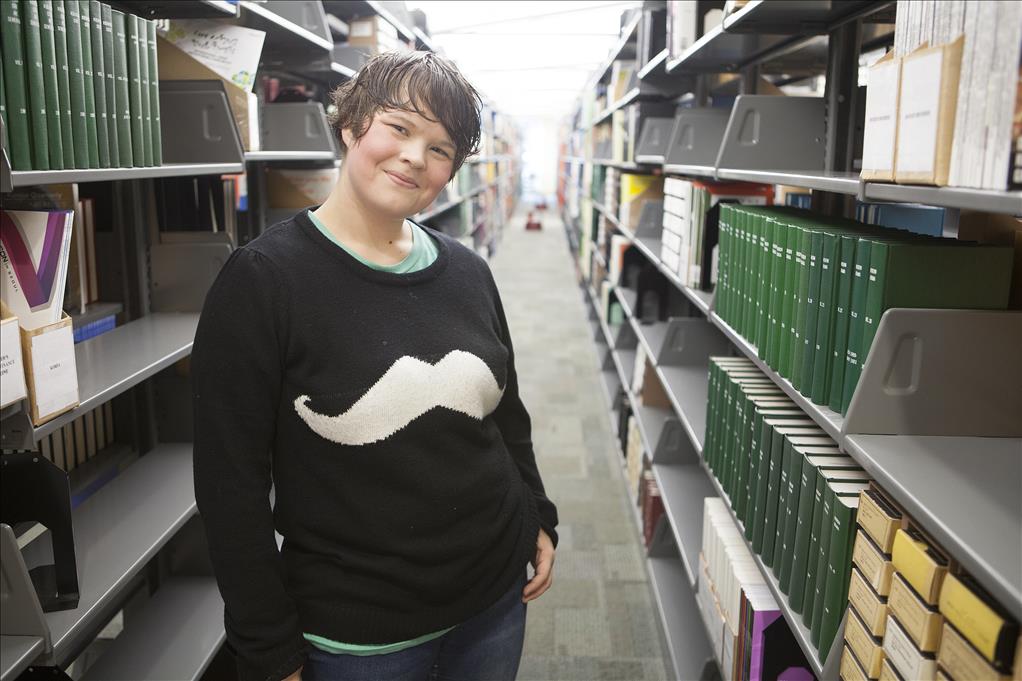Fighting the pandemic wars from a virology lab at UAA
by Kathleen McCoy |
The buzz and happy blur of UAA Commencement has faded, but the run up to that day is still vivid in student minds. April's calendar was filled with students delivering their final projects of the semester under the guidance of campus faculty.

Molecular biologist Eric Bortz, left, works with undergraduate researcher Rob Robl in the Bortz virology lab. Photo by Philip Hall/University of Alaska Anchorage.
Two undergraduate research presentations that caught my eye both came from graduating seniors who'd worked in molecular biologist Eric Bortz's virology lab. One had unpacked the genetics behind the 1918 Spanish flu. The other had used a virus to attempt an attack on cancerous tumors. Pretty ambitious.
Bortz has been at UAA just two years, arriving from his post-doctoral work in antiviral proteins at Mount Sinai School of Medicine in New York City.
What Bortz brought to Alaska was the idea of researching the innate defenses existing in every cell, and figuring out why they fail in the face of viruses, or if they can be recalibrated to perform better.
These defense mechanisms have odd names like NF90 and HNRNPA1. To get a sense of how they might fight a virus, imagine a building protecting itself from attack.
"So, you might have towers, and barbed wire and guards," he warms to the story. "And search lights and heat sensors..."
"And barking dogs?" I ask.
"Yes!" he says enthusiastically. "These might be the dogs. They bark when there is something there. And the others might be the fence and the barbed wire. So they are all components of this defense system, and it had gone unrecognized before."
His lab focuses on three areas:
- how some viruses manage to evade our immune system
- how our immune system might be tasked with attacking cancerous tumors
- and in HIV therapy, how the immune system might trick latent infection into revealing itself for an immune system attack
"So a lot has grown out of coming in to look more closely at these antiviral factors," Bortz says. "And almost all the work here has been done by undergraduates."
Bortz talks about his new UAA lab as if it were a Silicon Valley start-up.
"A biomedical lab is very resource and personnel intensive, not unlike a start-up in the computer or software industry," he said. "You have a small group of people who have a few good ideas. The challenge is keeping everybody focused on something they are very interested in doing, at the same time you're trying to achieve scientific goals or develop new ideas for therapies."
Like start-ups, finding money to pay for the work is a challenge. To get his new lab up and running, Bortz tapped federal research dollars and got financial support from UAA's College of Arts and Sciences and his own Department of Biological Sciences.
Federal funding came through the National Institutes of Health IDeA Network of Biomedical Research Excellence (INBRE), funding biotechnical research at all three University of Alaska campuses. "They provided significant start-up money for this work," Bortz said. "They want to build biomedical research capacity here in Alaska."
Call it job security, but as the world's population blows past seven billion, Bortz said we can expect many more infectious outbreaks, epidemics and pandemics. Some is probably due to better reporting, but a lot is pegged to increasing populations moving into more unpopulated or semi-populated areas. There they encounter new dangers, like a new species of bat that carries coronaviruses.
(Remember SARS from back in 2003? That was a coronavirus. It caused about 8,000 respiratory infections and killed about 10 percent of its victims.)
All these extra people mean many more mouths to feed. Enter the dangers of intensive agriculture.
"Now we need farms with one million pigs on them," says Bortz. "Do we survey those one million pigs for swine flu?"
He answers his own question: "Porcine epidemic diarrhea is another coronavirus that is epidemic in the United States right now."
Every time he teaches his virology class, he can point to new outbreaks. "I never have to use the same material," he says. "We have the new Middle Eastern Syndrome respiratory virus. There's H7N9 in China right now. Next year it's going to be the new ebola virus in West Africa."
Besides his passion for virology, Bortz also brought to Alaska his working role in an NIH-funded influenza-fighting network with global partnerships, responsible for surveillance of domestic and wild bird populations and other species like swine and marine mammals.
It's called the Centers of Excellence for Influenza Research and Surveillance, or CEIRS. Most significantly for infectious disease control, says Bortz, "all our data is open. We're basically the Amazon of influenza data" to enable outbreak information to travel even faster than the pandemic itself.
A version of this story by Kathleen McCoy ran in the Anchorage Daily News on Sunday, April 27, 2014.
 "Fighting the pandemic wars from a virology lab at UAA" is licensed under a Creative Commons Attribution-NonCommercial 4.0 International License.
"Fighting the pandemic wars from a virology lab at UAA" is licensed under a Creative Commons Attribution-NonCommercial 4.0 International License.














